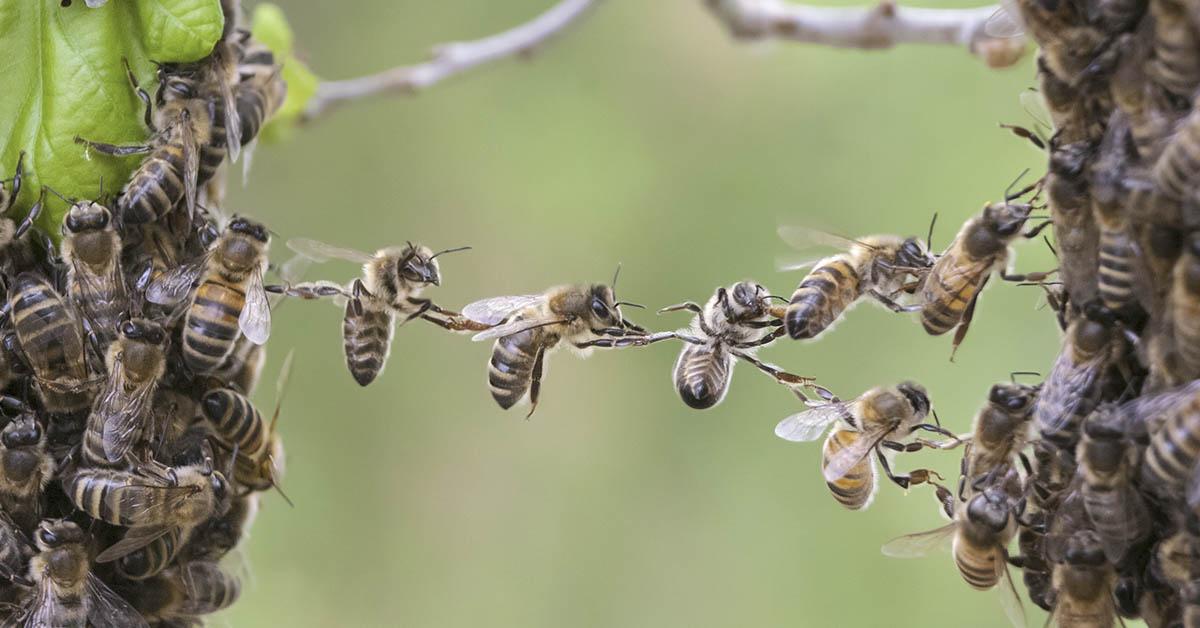Researchers accidentally discovered that swarming bees can produce an electric charge. Ellard Hunting and his colleagues at the University of Bristol in the UK were tracking weather in a field station. However, their electric field monitors found an increase in atmospheric electric charge although there were no storms around. The researchers realized the charge came from a swarm of western honeybees looking for a new home. [1]
Swarming Bees Can Produce Electricity
Science has already known that single bees carry a small electric charge. Flowers can use electric fields to attract pollinators. While flowers carry a slight negative charge around them, bumblebees have positive charge created by the friction of the air and their body parts while flying. Research has found that bees use this charge to detect sweet flowers while foraging.
Then, when a bee lands on a flower, it leaves its positive charge for about 100 seconds, which tells other bees that this flower has already been visited. Plus, bees’ charges helps keep the pollen stuck on them. [2]
“We study how different organisms use the static electric fields that are virtually everywhere in the environment,” said Hunting. “For instance, flowers have an electric field and bees can sense these fields… Or trees create an increased electric field in the atmosphere, and spiders can use this electric field to take off, and balloon, allowing them to migrate over large distances.”
However, this high voltage from swarming bees has never been recorded before. Using electric field monitors and video cameras, the researchers waited for bees near hives to naturally swarm. They documented three swarms around the monitors for about three minutes at a time. There, they discovered that these swarms can generate 100 to 10000 volts per meter. The more dense the swarm, the stronger the electric field. “When I looked at the data, I was kind of surprised to see that it had a massive effect,” says Hunting. [3]
Read: Terrifying close-up of ant’s face wins Nikon’s photo competition prize
Animals Using Electricity in Nature
Hunting compared the swarm’s charge to events like thunderstorms, electrified dust storms, and fair-weather storm clouds, and discovered that highly-dense bee swarms produce a stronger charge than all of them. In fact, it was six times stronger than a dust storm and eight times stronger than a cloud in a thunderstorm. However, bees aren’t replacing gas or solar power any time soon; it would take about 50 million bees to power one LED light.
Victor Manuel Ortega-Jiménez at the University of Maine comments on the discovery saying that it’s unclear if this charge helps the swarm for a specific purpose or if it is an accidental byproduct of the friction caused by flying. He adds that his phenomenon may be occurring in other flying and swarming animals, like bats and birds. “These are all interesting questions that this paper opens to investigate,” he says.
Science has found many other animals who use electricity to survive, but the well-known examples are mostly fish. For example, sharks use electroreception to detect the small amount of energy given off by living creatures. Platypuses use electroreceptors in their snouts to detect currents, burrow, and hunt with their eyes closed. More famously, the electric eel (a misnomer because it is technically a fish) can expend a powerful amount of electricity, enough to stun a horse, through three organs made of electrolytes. This marine animal played a pivotal role in teaching humans how electricity works, even inspiring the invention of the battery. [4]
Read: A Swarm of Bees Once Followed a Car for 2 Days to Rescue Their Queen
The Potential Effects of Insects on the Weather
Meanwhile, the researchers at the University of Bristol have already begun looking into the potential atmospheric electric charge of other kinds of insects. They created a model to predict other species’ potential, including moths, butterflies, and locusts — albeit “locusts swarm on biblical scales, according to biologist and co-author Liam O’Reilly. They predict that locusts can create a bigger charge than swarming bees because of their increased density and size. Clouds of locusts can span up to 460 square miles, with roughly 80 million locusts per square mile. [5]
This study is only one example scientists trying to discover how electricity is used within nature. “We only recently discovered that biology and static electric fields are intimately linked and that there are many unsuspected links that can exist over different spatial scales, ranging from microbes in the soil and plant-pollinator interactions to insect swarms and the global electric circuit,” says Hunting. “This makes it an exciting new area of empirical research. The true implications of this remain speculative, and whether these dynamics induced by insects affect weather is definitely worth investigating.” [6]
Keep Reading: These Special Bees Crafted Nests From Flower Petals
Sources
- “Observed electric charge of insect swarms and their contribution to atmospheric electricity.” iScience. Ellard R. Hunting. October 24, 2022.
- “Honey, It’s Electric: Bees Sense Charge On Flowers.” NPR. Adam Cole. February 22, 2013
- “Honeybee swarms generate more electricity per metre than a storm cloud.” New Scientist. Corryn Wetzel. October 24, 2022.
- “The world’s most electric animals.” BBC Earth. Matilda Battersby.
- “Honeybee Swarms Can Produce as Much Electric Charge as a Storm Cloud.” Smithsonian Magazine. Sarah Kuta. October 28, 2022
- “A swarm of honeybees can have the same electrical charge as a storm cloud.” Popular Science. Laura Baisis. October 24, 2022

